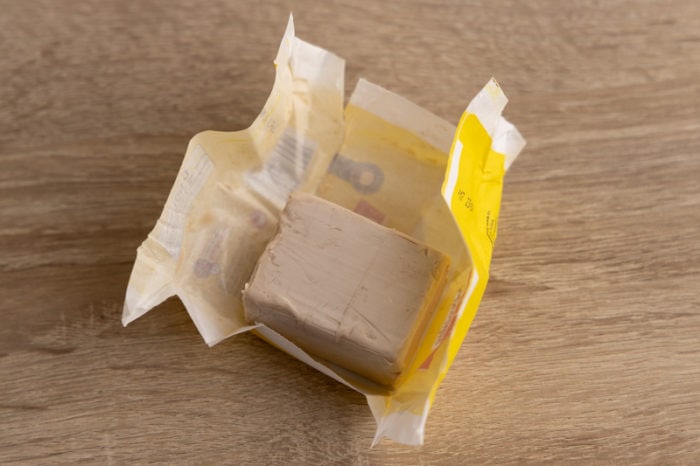Fresh yeast is preferred by many bakery professionals, since when it ferments, it produces more gas than dry yeast, which makes breads and pastries puffier. However, fresh yeast lasts much less than its dehydrated version, which is why many people, think twice before buying it.

Thinking about this, you might be wondering: “can fresh baker’s yeast be frozen?“. The answer is yes, but like everything in the kitchen, it has its technique. For this reason, we tell you everything about how to preserve yeast, whether fresh or frozen, as well as many other tips about this important ingredient. You cannot miss it!
How to preserve fresh yeast?
Unused fresh yeast keeps well refrigerated for a month or less. You will know the exact date by checking the preferred use date on the packaging. Once opened, it lasts two weeks and, from this moment, the loss of its leavening power accelerates. If you have already unpacked it and used it in a recipe, you must follow these steps to store it properly:
- Distribute the yeast into portions (blocks).
- Place the yeast pieces in a special container or bag for freezing food(although you are not going to freeze them). The container must have a lid and the bag must have a closure.
- Hermetically close the chosen container or packaging.
- Tag it. Enter the expiration date indicated on the original packaging of the yeast, as well as the date you packaged it and the name of the product.
- Put it well in the refrigerator. Do not crowd the container or bag with other products; let the air circulate around it.
- The ideal temperature to keep fresh yeast in the refrigerator is between 4 and 8°C.
- Use it as soon as possible, as fresh yeast quickly loses effectiveness over time.
- It prevents the yeast from suffering very sudden changes in temperature.
How to freeze fresh yeast?
If you have the yeast reserved for a special recipe or bought a lot, it is best to freeze it. Thus, as we have indicated previously, yes, fresh yeast can be frozen. Frozen yeast can be kept well for around 1-2 months, since any longer can cause the total or partial loss of its leavening property. Even before the expiration date, the product may lose some of its effect due to the freezing process, so when preparing a recipe you will need to add more yeast than indicated.
Freezing fresh yeast is very simple and quick, as long as you follow these easy steps:
- Check the preferred use date. If this date has passed, you will not be able to freeze fresh yeast.
- Divide the yeast into portions (blocks). Thus, you only use what you need and avoid freezing it again. Otherwise, the yeast would suffer sudden changes in temperature and lose its effectiveness.
- Wrap them in plastic wrap. Do it very well so that no part is exposed to cold or moisture. This step ensures that the yeast is isolated.
- Deposit the portions in a special container for freezing that has a lid. This allows you to close the container tightly. If you prefer a bag, choose one that is zippered and designed for high temperatures.
- Identifies the container or packaging with a label. Write down the packaging date, product name and expiration date indicated on the package.
- Put the container in the freezer. Do it in a way that circulates the air around the container or bag.
How to thaw fresh yeast?
Although there are people who use it without thawing, that is, adding it directly to the preparation, it is best to thaw it slowly following these instructions:
- Take the yeast out of the freezer and place it in the refrigerator.
- Let it thaw little by little. The total thawing time for fresh yeast will depend on the size of the piece (block). In this way, the yeast will not suffer a drastic change in temperature and, therefore, will not lose its faculties.
- Once thawed, remove it from the refrigerator and dry its container very well. Before removing the yeast from its container, dry the outside of the container very well. Then, dry the plastic wrap that surrounds it.
- Use the yeast immediately.
How to know if the yeast is good?
Now that you know that fresh yeast can be frozen to make bread, how to do it and how to thaw it, it is normal for you to wonder how to know if it is really good. Well, if you have doubts about the state of your yeast, whether frozen or refrigerated, it is best to submit it to a test. In fact, this procedure is always advisable, but especially if you froze it. This test is very simple and only requires you to follow the following steps:
- Heat a little waterand remove it when you feel it warm-warm. You’ll know it’s the exact spot if you can stick a finger in it without burning yourself. The ideal temperature is close to 40 °C. Never use hot water (that is, 50 ° C degrees and above), as it kills the microorganisms of the yeast, deactivating it and causing it to lose its leavening power.
- Pour two fingers of water in a glass and add 1/2 tsp. of sugar.
- Add a piece of yeast and dissolve well. You must crumble the yeast beforehand.
- Wait between 5 and 10 minutes.
- If the mixture looks foamy, the yeast is activeand will proof the dough without any problem. On the contrary, if this does not happen, the yeast has already lost its properties, it is not good and you must discard the entire batch.
Can you use expired fresh yeast?
If you want to prepare a recipe but the only yeast you have is expired, don’t worry, you can use it as long as you check if it is still good. Of course, the product must not have exceeded the expiration time too much, maximum 1 or 3 days.
Once expired, the yeast can react in two ways: lose much of its leavening effect or be completely inactive. If you are lucky and it is still active, it will still rise but it will rise very slowly. In such a case, to counteract this problem, you can use more of this yeast.



